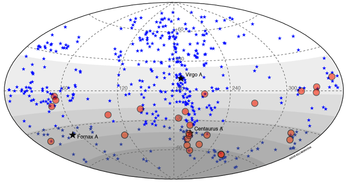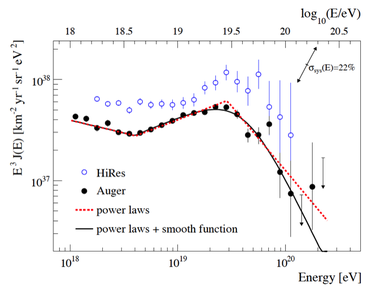Cosmic rays are fundamental particles (i.e. protons or other, heavier nuclei) that are accelerated in astrophysical sources to tremendous energies, surpassing man-made accelerators like the LHC by several orders of magnitude. When they collide with the molecules in the Earths atmosphere they initiate a shower of secondary particles, an extensive air shower. These shower can be detected by particle detector arrays on the ground or fluorescence telescope monitoring the atmosphere. Both detector types are implemented in a hybrid setup at the Pierre Auger Observatory, the largest detector in the world.
I started my scientific career by studying ultra-high energy cosmic rays (UHECR) with the Pierre Auger Observatory and this starting point is still one of the main driving forces behind my current research.
During my diploma thesis I introduced a novel event reconstruction technique for extensive air showers (29th ICRC, 2005) and was awarded with the Edison Award 2005 (General Electric Foundation) and the Helmholtz young scientist award for the best German diploma thesis in astroparticle physics in 2005.
During my PhD thesis I worked among other topics on a cross-check analysis searching for correlations between cosmic rays and active galactic nuclei (“Correlation of the highest-energy cosmic rays with nearby extragalactic objects”, Science 318 (2007) 938), Very intriguing at the time, the correlation has not been strengthened with more data collected over the years since the publication. I also developed the tools necessary to determine the exposure of the Pierre Auger Observatory (“The exposure of the hybrid detector of the Pierre Auger Observatory”, Astropart.Phys. 34 (2011) 368) and especially introduced a time dependent scheme for the Monte Carlo simulations (RealMC) reproducing the exact data taking conditions of the full observatory with all its subsystems, the changing atmospheric conditions, etc. Using these methods I was able to derive the first energy spectrum of UHECRs based on hybrid measurements (i.e. combining the information from the two distinct detectors of the Pierre Auger Observatory). The corresponding paper is: “Measurement of the energy spectrum of cosmic rays above 1018 eV using the Pierre Auger Observatory”, Phys. Lett. B 685 (2010) 239).
During my diploma thesis I introduced a novel event reconstruction technique for extensive air showers (29th ICRC, 2005) and was awarded with the Edison Award 2005 (General Electric Foundation) and the Helmholtz young scientist award for the best German diploma thesis in astroparticle physics in 2005.
During my PhD thesis I worked among other topics on a cross-check analysis searching for correlations between cosmic rays and active galactic nuclei (“Correlation of the highest-energy cosmic rays with nearby extragalactic objects”, Science 318 (2007) 938), Very intriguing at the time, the correlation has not been strengthened with more data collected over the years since the publication. I also developed the tools necessary to determine the exposure of the Pierre Auger Observatory (“The exposure of the hybrid detector of the Pierre Auger Observatory”, Astropart.Phys. 34 (2011) 368) and especially introduced a time dependent scheme for the Monte Carlo simulations (RealMC) reproducing the exact data taking conditions of the full observatory with all its subsystems, the changing atmospheric conditions, etc. Using these methods I was able to derive the first energy spectrum of UHECRs based on hybrid measurements (i.e. combining the information from the two distinct detectors of the Pierre Auger Observatory). The corresponding paper is: “Measurement of the energy spectrum of cosmic rays above 1018 eV using the Pierre Auger Observatory”, Phys. Lett. B 685 (2010) 239).
Cosmic rays and AGNsArrival direction of ultra-high energy cosmic rays detected by the Pierre Auger Observatory (red circles) in correlation with the position of Active Galactive Nuclei (blue stars). From R. Engel and F. Schüssler, Spektrum der Wissenschaft, 01/2008
|
The cosmic ray fluxThe energy spectrum of ultra-high energy cosmic rays detected by the Pierre Auger Observatory (black points). This is the main result of my PhD thesis and has been published in Phys.Lett.B 685 (2010) 239.
|

